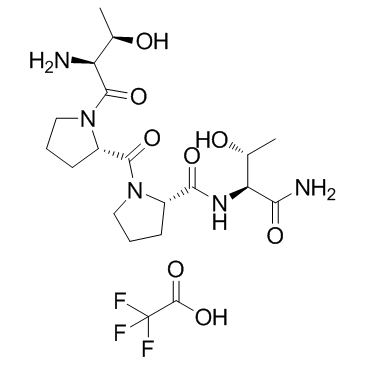Rapastinel Trifluoroacetate
Modify Date: 2025-09-06 19:10:10

Rapastinel Trifluoroacetate structure
|
Common Name | Rapastinel Trifluoroacetate | ||
|---|---|---|---|---|
| CAS Number | 1435786-04-1 | Molecular Weight | 527.49 | |
| Density | N/A | Boiling Point | N/A | |
| Molecular Formula | C20H32F3N5O8 | Melting Point | N/A | |
| MSDS | N/A | Flash Point | N/A | |
Use of Rapastinel TrifluoroacetateRapastinel Trifluoroacetate is an NMDA receptor modulator with glycine-site partial agonist properties and currently in a phase II clinical development program as an adjunctive therapy for major depressive disorder. |
| Name | Rapastinel Trifluoroacetate |
|---|
| Description | Rapastinel Trifluoroacetate is an NMDA receptor modulator with glycine-site partial agonist properties and currently in a phase II clinical development program as an adjunctive therapy for major depressive disorder. |
|---|---|
| Related Catalog | |
| Target |
NMDA receptor[1] |
| In Vivo | Rapastinel Trifluoroacetate is an NMDA receptor modulator with glycine-site partial agonist properties and currently in a phase II clinical development program as an adjunctive therapy for major depressive disorder. Mice given Rapastinel Trifluoroacetate (1.0 mg/kg) prior to acute ketamine (30 mg/kg) show clear preference for novel compare to familiar objects (P<0.01)[1]. Rapastinel Trifluoroacetate produces an antidepressant like effect in the USVs test, as indexed by an increase in hedonic 50-kHz USVs [F(1,20)=12.4, P<0.05] and a decrease in aversive 20-kHz USVs [F(1,20)=6.8, P<0.05]. Rapastinel Trifluoroacetate also produces an anxiolytic effect in the open field, as indexed by increased center time [F(1,20)=19.2, P<0.05] without altering locomotor activity as measured by line crosses [F(1,20)=0.0, P>0.05][2]. |
| Animal Admin | Male C57BL/6J mice are used in this study. Mice are group housed (five/cage) in a controlled environment held at 21±2°C with a 14:10 h light-dark period (lights on:±05:00 am). All experiments are conducted during the light phase. Food and water are available ad libitum. For acute drug treatments, Rapastinel Trifluoroacetate (1.0 mg/kg, iv) is administered 30 min prior to the acquisition trial of the novel object recognition (NOR) task to the subchronic ketamine or subchronic phencyclidine (PCP)-treated animals[1]. |
| References |
| Molecular Formula | C20H32F3N5O8 |
|---|---|
| Molecular Weight | 527.49 |
| InChIKey | BCWVNVCGYWOAAK-GDLIIDCZSA-N |
| SMILES | CC(O)C(N)C(=O)N1CCCC1C(=O)N1CCCC1C(=O)NC(C(N)=O)C(C)O.O=C(O)C(F)(F)F |
| Storage condition | 2-8℃ |